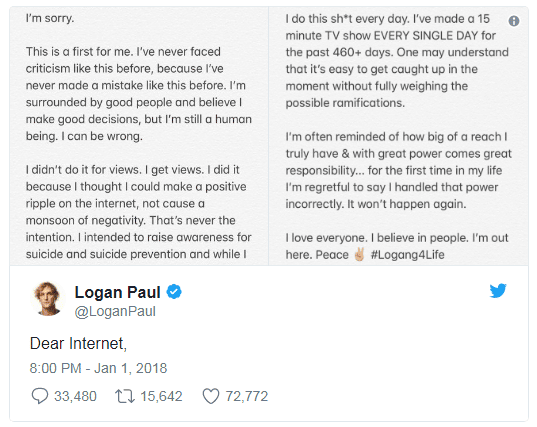Mistakes happen. You’ll be judged on what you do next.
YouTubers are a controversial topic. If you’re a teen or young adult it’s likely you have your own favorites that you’ve spent hours watching, and you may even feel deeply connected to a streamer you’ve followed through their daily lives. If you’re a bit older you probably range from being vaguely annoyed at the phenomenon to actively hating the blitz of content put out with little vetting and an overdose of shouted catchphrases.
What most of the country seemed to agree on recently is the poor taste of one Logan Paul, a vlogger and social media phenomenon with an estimated 19.4 million followers, many of them preteens or teens. Paul posted a video from Japan’s eerie Aokigahara “suicide forest”, where hundreds of people per year attempt to take their own lives. During the video he comes across a suicide victim’s body hanging from a tree branch….and proceeds to continue filming, crack several jokes about the deceased, then heads home to upload it all to YouTube.
Backlash came quickly, and we were all set to tear Paul’s original apology a new one.

This is a terrible apology. The “feel” of it is certainly consistent with Paul’s brand, and it’s likely his regular viewers took the message well. The problem is that his regular viewers are not the audience he needs to be concerned about in this situation – it’s their parents, his sponsors, and future potential employers, advertisers, etc. that needed to hear a message they could accept.
In crisis management for situations like this we talk about three audiences: 1) your fans who will stand by you no matter what, 2) your haters who aren’t going to ever be convinced you’re worth their time, and 3) those who are on the fence, unsure whether you’re truly a villain. If you only talk to those who are already your fans it’s wasted breath. If you can win the hearts and minds of the fence sitters you’ve accomplished something.
The apology got a bad reaction around the internet because, well, it was bad. Obviously someone in Mr. Paul’s camp realized this because a MUCH improved video apology was published the next day.
Note the differences – not just in the feel from a tearful face delivering the message, but in the actual wording. The bravado is gone, the YEE BOI facade is down, and you’re suddenly looking at a young person who knows they made a mistake, something any of us can relate to regardless of age or entertainment preferences. He stays humble, he stays compassionate, and he doesn’t ask for forgiveness in the process. If it’s acting it works. Credit where credit is due, this apology is good.
This situation isn’t going to topple someone who’s playing YouTube like a fiddle day in and day out, but there were powerful lessons learned. A bad apology throws fuel on the fire, a good one starts to smother the flames of discontent. That’s how it works when we’re talking crisis management.
Erik Bernstein
[email protected]
www.bernsteincrisismanagement.com
Connect with Erik on LinkedIn!
